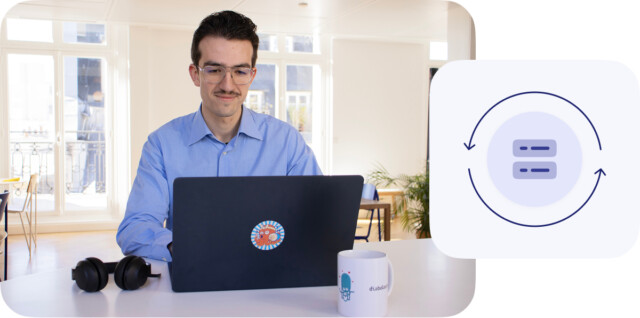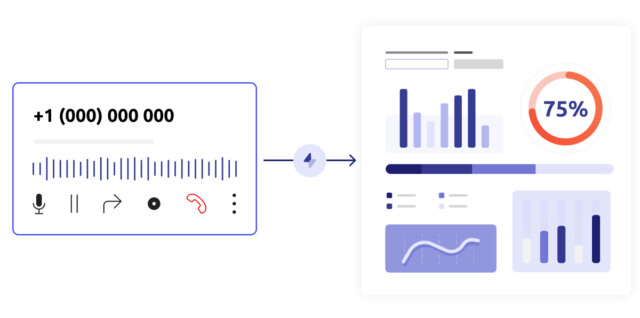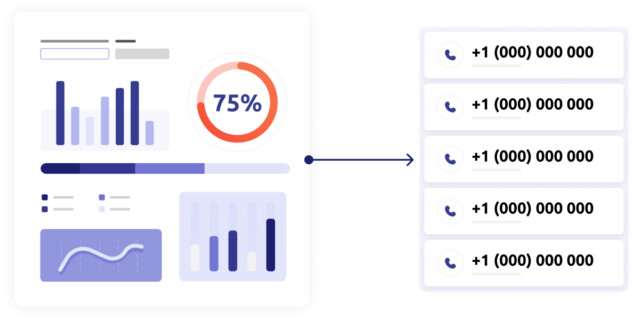Real Time Data Processing
Turn every customer interaction into a data-driven opportunity with Diabolocom
What is Real Time Data Processing?
Unlike batch processing which handles data at scheduled intervals, real time data processing refers to the immediate or near-instantaneous handling of incoming data with minimal latency. Thus, real-time systems ingest and process data quickly to deliver actionable insights on-the-fly, enabling businesses to stay agile and responsive. This capability is especially critical in fast-paced environments with high complexity or human interaction—such as contact center solutions and customer service.

Benefits of Real Time Data Processing
Quick Detection of Customer Experience Issues
Diabolocom enables quick detection of customer experience issues through feedback loops. Managers are notified of emerging dissatisfaction or recurring issues among customers immediately after they occur. As a result, your retention team can follow up or take action while the issue is still fresh, reducing churn risk and improving customer service. In addition, Diabolocom’s system provides diverse detection features such as satisfaction analysis, and call metrics (like duration and resolution rate).

Smarter Data-Driven Call Routing
Diabolocom analyzes call patterns, customer satisfaction metrics, and agent performance trends to enable dynamic adjustments and smarter call routing for contact centers. Armed with AI data processing capabilities, contact centers using Diabolocom can balance agent workloads intelligently, proactively responding to surges in call volumes and matching customer profiles to agent strengths. Boost first call resolution rates and route calls to the right agents instantly based on agent availability, training, and specialized skills.

The challenges of Real Time Data Processing
Scalability and Infrastructure demands
Due to large amounts of live data being ingested, processed, and analyzed, real-time data processing requires a robust computing infrastructure capable of dealing with large fluctuations in data volumes. Since traditional batch processing systems often fall short of this requirement, cloud-based frameworks are needed.
Data Quality and Consistency
In fast-paced environments, decisions are made automatically, leaving little time for data validation or cleansing. Even small issues like timestamp mismatches or out-of-sequence events can skew outcomes. The complexity increases with data from various sources, such as IoT devices, CRMs, social feeds, and mobile apps.
Uses of Real Time Data Processing
Enhance Customer Experiences with Queue Health Monitoring
Diabolocom provides data-driven visibility into queue dynamics──such as average wait times, abandonment rates, agent availability, and call volume patterns. Prevent queue overload by alerting managers immediately, allowing for better staffing decisions.

FAQ
How is real-time data processing different from batch processing?
Real-time processing involves interacting with data at the same moment (or shortly after) it is generated, while batch processing extracts data and performs analysis at a defined interval. Real-time systems are best suited to applications that require immediate decisions or responses, such as customer interactions.
What technologies support real-time data processing?
Key technologies include stream processing frameworks (e.g., Apache Kafka, Flink), in-memory databases, edge computing, and AI/ML algorithms integrated with live data pipelines.
What are the common challenges in implementing real-time systems?
Common challenges to real time data processing include infrastructure costs, system scalability, ensuring data quality, managing latency, and maintaining security and compliance in high-speed environments.
Can small businesses adopt real-time processing?
Yes, cloud-based platforms and managed data services make it increasingly accessible to small and medium-sized businesses looking to improve responsiveness and gain competitive advantage. Solutions like Diabolocom offer scalable capabilities tailored for growing teams in fast-paced envrionments──without the need for complex infrastructure.
What are the benefits of real-time data processing for managers?
From queue optimization to resource allocation (staffing), proactive actions, faster feedback loops, and churn risk detection, platforms like Diabolocom offer a multitude of benefits for managers in the customer service sector.